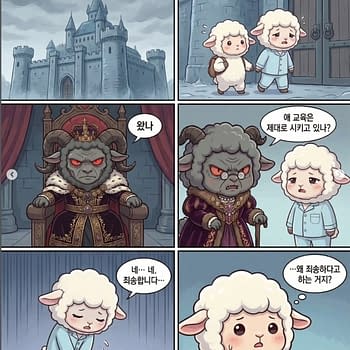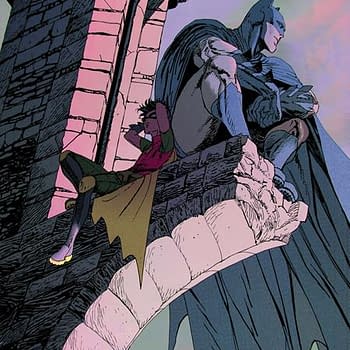Posted in: Comics | Tagged: all ages, censorship, code, dc, marvel
How Marvel, DC And You Can Save The Comic Industry by Phil Hampton

This is with a message of hope for the future. Or rather it's a call for a change of focus to give this great industry a long and prosperous future. And the good thing is that, whether you're a creator, retailer, publisher or consumer, you can help to lead this change.
The Most Important Marvel and DC Comics Titles (and they're not what you think!)
There are a few titles that Marvel and DC print that, from a marketing point of view, could be financial dynamite. But they are often launched with little or no fanfare, and are rarely promoted anywhere near as heavily as their flagship books featuring their main characters.
But these low-key books also feature their main characters.
Confused? I'll explain.
Marvel have a line of books called 'Marvel Kids' (http://marvelkids.marvel.com/), and DC have a similar line called 'DC Comics Kids' (http://dckids.kidswb.com/). Having a look at the respective websites, I must admit that both are doing a decent job of making these lines appealing to kids, with a handful of decent digital comics, some TV show episodes, games and puzzles. Marvel's titles have included Superhero Squad, Marvel Adventures and various Power Pack team-ups, whilst DC have Batman: Brave and the Bold, Super Friends and Justice League Unlimited.
But the published comics reveal a different story.
Having a look through Marvel's entire published comics line at the moment (in the latest 'Marvel Previews' magazine for titles shipping September 2011), there are 88 titles rated either 'T+' for those aged 12 and above (65 titles), 'Parental Advisory' (17 titles), 'Mature Content' (3 titles) or 'Explicit Content' (3 titles). There are no titles rated 'A' for those aged 9 and over.
Only 7 titles are labelled 'All ages'. They are:
John Carter: A Princess of Mars (mini-series) – $2.99
Dorothy & The Wizard in Oz (mini-series) – $3.99
Super Heroes – $2.99
Spider-Man – $2.99
Muppets Presents (one-shot) – $5.99
Marvel Super Stars Magazine – $7.99
Avengers: Earth's Mightiest Heroes Magazine – $9.99
Bearing in mind that Marvel see themselves as a super-hero focused company, it's strange to see almost half of its 'All Ages' titles as non-superhero. It's also jarring to see that two of its four all-ages superhero titles are priced at $7.99 and $9.99 – far from pocket-money prices.
So the average under-twelve superhero fan will most likely be swayed to 'Spider-Man' and 'Super Heroes'. Now having one title dedicated to your most popular character, and another with a rotating cast of major characters isn't bad, but Marvel are hardly milking the kids market compared to the rest of their output.

Meanwhile, DC have 6 'All Ages' titles shipping in September 2011:
Batman: Brave and the Bold – $2.99
Tiny Titans – $2.99
Young Justice – $2.99
Scooby Doo, where are you? – $2.99
Cartoon Network Action Pack – $2.99
Looney Tunes – $2.99
So they have three superhero titles, all priced at $2.99. Slightly better than Marvel, but come on DC – where's the Superman title?
Bearing in mind that DC are relaunching all 52 of its mainstream titles in September, all of them are rated either 'T' or 'T+' (and of course all Vertigo titles are for Mature Readers), so again under-twelves are ignored.
I hoped that a title like Supergirl may cross over to under-teens, like the Lee/Ditko Spiderman. But then I read the promotional spiel – "Meet Supergirl. She's got the unpredictable behaviour of a teenager, the same powers as Superman – and none of his affection for the people of Earth. So don't piss her off!"
So that'll be a 'No', then.
(NOTE – There was an exaggerated 'Cartoon Network'-style Supergirl title from 2008 called 'Supergirl: Cosmic Adventures in the 8th Grade', but it seems that titles with a more mainstream style of super-heroics are no longer deemed appropriate for young kids at DC.)
DC have said that their 'New 52' relaunch strategy aims to attract new readers to the market, and I hope it does, but they've missed a trick by focusing it on those aged 12 and over.
What's so special about kids comics?
There's a strong reason that I'm making such a big deal of the under-twelve market. I got hooked on comics at the age of 9 after reading a UK Spider-Man reprint comic, which tied into the brand new live-action TV show. I remember reading in that issue about Spider-Man fighting the Gibbon and the Beetle before they were laden with nineties-style irony. At the same time I started collecting the French 'Asterix' books by Goscinny and Uderzo which were great fun.
Just over a year later I read Alan Moore's Captain Britain saga (from the UK magazine 'The Daredevils') which blew my mind. I devoured classics like John Byrne's Alpha Flight, Chris Claremont's X-Men, Roger Stern's Spider Man and Avengers and David Michelinie's and Bob Layton's Iron Man – all before hitting twelve.
At that age I was in awe of the stories. They seemed consistently brilliant, possibly because my critical faculties hadn't fully developed, but there was definitely magic in the air.

As I hit my teens I came across the first specialist comic shop close to my school and started buying more titles. The classic stories became less frequent but there were some amazing highs– Byrne's Man of Steel and his sterling run on West Coast Avengers, Silver Surfer by Steve Engelhart and Marshall Rogers, Walt Simonson's X-Factor, Peter David's Hulk, and Justice League by Keith Giffen and J.M. DeMatteis.
I feel privileged to have experienced the worlds of Marvel and DC at an age when my imagination was firing on all cylinders. I had well and truly fallen in love with comics.
But here's the question – would I have been reading these stories as a teenager if I hadn't fallen into the world of comic books at such a young age? I can't definitively say that I would have.
There are also millions of kids who are unaware of printed comic books, or even webcomics, which could give them all the spills, thrills and chills that would benefit them at that age.
And making them aware is the problem.
When I was a pre-teen, I bought all of my comics at the newsstand. Nowadays, in the UK at least, there are a few magazine-style comics such as Batman: Brave and the Bold, which come with puzzles, games and a free toy, and usually tie into cartoon series. But their 'all ages' comic book counterparts aren't advertised within them. Those comic books, which could be sold in their tens of thousands to kids via newsstands or supermarkets are reserved for specialist comic shops which are mostly frequented by people over fifteen.
What's more, superhero movies are now solely rated for over 12s so the long-term boost in younger readers that the Christopher Reeve Superman movies brought about at the time of their release is unlikely to reoccur these days.
Now, I say 'long-term boost' because, in my opinion, the younger that one becomes a fan of comic books, the more likely they are to become a long-term reader of comics.
Why do I think that? The main reason is the nostalgia factor.
Even today I buy comics to reignite the thrill that I experienced reading those wonderful titles from the early eighties when aged 9 to 11. My high expectations are rarely met, but I still hold out hope. I'm especially looking forward to a number of the relaunched DC titles, hoping that I will be amazed, intrigued and enthralled in the same way that those titles enthralled me decades ago.
But another reason to focus on younger readers is that the world around us has changed in ways which make it more difficult for comic publishers to attract and retain readers of an older age.
Teens and young adults these days have a much greater number of distractions than just twenty years ago – mobile phones, hand-held games, all-day kids' TV, the internet and social networking, and now streaming music and movies. And I haven't even mentioned homework and the opposite sex.
Then there are people's pre-instilled beliefs about comics to overcome. I can imagine this type of conversation outside comic stores on Free Comic Book Day:
Retailer: "Want some free comics?"
Teenager: "No thanks. Comics are for kids."
Retailer: "Not any more. These days comics are almost solely targeted at teenagers."
Teenager: (pauses) "Comics are for nerds." (Goes to see the latest Transformers movie.)
This is partly why I feel that aiming 95% of your titles at those aged 12 and above is a flawed strategy.
It's better to focus on kids at a younger age when they've got fewer distractions in their lives and no misguided preconceptions about the material. Then the positive message about comics is more likely to 'stick' and be readily accepted.
There are only so many hours in the day and comics have to compete against much flashier (and arguably compelling) forms of entertainment. And, let's be honest, the marketers persuading kids down those other avenues are doing a much better job than the comic industry at the moment.
Education, Education, Education
Just have a look at the Free Comic Book Day website (http://www.freecomicbookday.com). FCBD is a great initiative to get new readers involved in comics, but I had trouble finding a section explaining why comics are a great form of entertainment. When I finally found it, (question 9 of the FAQs) all it said was:
"What's the big deal about comic books anyway? Comic books are an original American art form, created in the early days of the twentieth century. They are fun to read, featuring a wide range of diverse story lines that capture the imagination of the readers. That's worth celebrating in our book – we're proud to be a part of this wonderful medium." This was followed by a link to the history of comics.
It's a good start, with good intentions, but the message could be communicated much more clearly and broadly. The list of reasons why comics are great should ideally have their own page on the site in order to attract the casual surfer.
Here's a great little video by Francoise Mouly, Art Editor at the New Yorker, about how comics taught her son to read. The industry could do with more of this type of advertisement.
Let's see how Marvel and DC are doing to get their Kids sites in the faces of young children (who may not equate the superheroes that they see on TV with the brand names 'Marvel' or 'DC').
When I type 'Spider Man' into Google, the 'Marvel Kids' website doesn't even appear in the first 10 pages (after which I gave up searching).
Yes, Spider Man's biography page on the Marvel website appears on page 1 of Google, and there a small 'Marvel Kids' icon in the top right-hand corner of the website, but when faced with a few thousand words of biography, many young kids will be prompted to switch to a different, more fun, site rather than hang around to check links.
It would be much better for Marvel to work on its SEO (search engine optimization) strategy for the Marvel Kids website, or to better promote the Marvel Kids brand, than rely on children clicking links from pages meant for over-twelves. Now that Marvel are owned by Disney, this will hopefully allocate a larger marketing spend targeted at younger readers, and cross-over with Disney products.
It's no better at DC. When I type 'Batman' or 'Superman'into Google, the DC Kids site isn't in the first 10 pages, and the link to the site is hidden at the bottom of the main DC comics homepage.
Then, after a while of looking around the DC Kids site, I found a tiny link at the bottom to 'Kids Jr', which is the main Warner Bros. Kids site (http://www.kidswbjr.com/). This features episodes of the 'Super Friends' cartoon, which serves as a great introduction to DC's heroes, but had I not scoured the DC Kids site for the purposes of this article, I wouldn't have found it.
One good thing of note – both the 'Marvel Kid' and 'Warner Bros. Kids J'' sites have pages for parents that describe how their sites educate and stimulate young kids minds. Such a page is missing from the DC Kids site. DC really need to rectify this, and soon.
Having 'Parents' pages is a good idea, but neither the 'Marvel Kids' nor 'DC Comics Kids' sites attempt to educate the audience in why the comics themselves are so great. This is the most basic of marketing techniques. Why should someone buy a comic if they've never bought one before? And more importantly why should they buy your comic in particular compared to the hundreds of titles released every month?
You would hope that the two companies who so strongly influence the comic book industry could make a better effort to educate the non-comics reading audience in the benefits of comics. They may be doing something out there, but I'm having trouble finding it.
Both companies could rectify that simply by adding 'Why read comics?' pages on their Kids sites. Even though they have to get the wording reviewed through reams of bureaucratic red tape, those pages could be live in a couple of weeks. If you've created your own all-ages comic or webcomic site, you could have such a page on your site live today.
Why printed comics are important
Let's return to printed comics.
Can we blame Marvel and DC with not marketing their printed comics so strongly to young kids? Many of today's commentators on the industry have already foretold the death of the printed comic book, predicting that in the next decade, digital comics will reign supreme.
And from a purely business perspective, the profits to be made on a digital comic significantly outweigh those of a printed book because of the lower costs of creation and distribution.
Well, here's my response to that – even if printed comics do not represent a massive income stream, they are an excellent lead generator. In other words, they help to generate interest in your product range, leading to new customers. And in a well-rounded marketing strategy, that can be worth its weight in gold. There are thousands of companies around the world who are prepared to make a loss on certain products, even give them away for free, in order to attract new customers to their product range, and hopefully keep them for the long-term.
So how can the industry promote printed comics to a wider audience, especially to those families who have little interest in comics?
There's the problem of getting them back into the likes of Wal-Mart where the general public will see them. Now that the Comics Code has vanished from the covers of regular books, it's more difficult for supermarkets to gauge the suitability of comics for their customers (a topic of great sensitivity for them).
 Ahhh – censorship. Those were the days…
Ahhh – censorship. Those were the days…
Writer Peter David wrote a good article in 1992 on how the Comics Code Authority was pure censorship. Here's the link.
Now, I'm not a supporter of artistic censorship, but the rejection of the CCA has allowed publishers to sideline 'all ages' comics, as I have already explained.
This has clearly been an intentional move by comics publishers, possibly as a natural reaction to being finally free of the censor's influence, and partly by them hankering to the trend of an ever-aging audience rather than trying to retain control of the boundaries of their target market through careful positioning.
We now need some common-sense to return to the industry, and revert to a more well-rounded marketing strategy.
Wouldn't it be an amazing thing to really push printed comics as an ideal, engaging form of education and entertainment that doesn't involve looking at a computer or TV screen?
There are already two major concerns that parents have, which the comic industry can use to its advantage. Firstly, that staring at a screen all day is bad for their kids, and secondly, that it's impossible for parents to always ensure that what they're watching is age-appropriate.
So here's a solution – comics that will help teach their kids to read, expand their vocabulary (NOTE – this was a favourite marketing technique of Stan Lee's) and offer them exciting, wholesome entertainment. All backed up by a pre-approved 'All ages' rating.
That's a strong reason for parents to introduce their children to comics, and for supermarkets to stock them.
Here's an idea – why don't Marvel and DC agree to distribute brand new titles, but solely containing classic pre-1990s reprints, along with some puzzles, posters, stickers and competitions? They could be printed on cheaper paper, further reducing the cost of production (young kids don't care about expensive glossy paper, and the original comics weren't computer-coloured anyway). And printing one or two-part stories that appeared prior to the crossover event boom would help both kids and parents feel in control of their buying habits in these difficult times. What's more, it no longer matters that in those stories Peter Parker isn't married…
Then, include adverts in these titles to lead the kids to the Marvel Kids or DC Comics Kids websites, plus the regular 'Kids' comic books that can only be found in specialist stores (thankfully both the Marvel and DC Kids sites include Comic Store locators), plus a subscription service for those titles.
Now, Marvel and DC already run subscription services (Go to http://subscriptions.marvel.com/ for Marvel, or click the 'Subscribe to DC' link at the bottom of the DC Comics Homepage) giving great discounts on their printed titles. Did you know that? I didn't until a few seconds ago after searching for them on Google.
I may be lambasted by suggesting to use old material and old marketing strategies to sell comics in today's market, but sometimes you have to look to the past to be able to move forwards. I said in my article last week that the mid-eighties were where the comic industry got its marketing and its content right, and the comments I've received since shows that this clearly resonated with some of you.
If comics were seen again as disposable rather than collectible items, enabling kids to pick up titles locally, and dip in and out of the stories whenever they wanted, it would build an army of long-term readers who then follow comics onto the internet when printed comics go the way of the vinyl record.
The New Movement in Comics
But I've talked enough about Marvel and DC. There's a small but growing movement that could end up filling the clear gap in the market that the 'big two' have left open.
'All ages' webcomics are a genre in themselves. There's even a directory of webcomics rating them for 'family friendliness' at http://www.familywebcomics.com.

When I interviewed Chris and Kyle Bolton, the creators of all-ages webcomic 'Smash' (check out their site http://www.smashcomic.com), it was refreshing to hear their enthusiasm for the character, and their target audience. Their website is an excellent example of a webcomic which engages and entertains young minds. Season 1 is about to be printed by Candlewick
Press, and Season 2 is ready to roll online.
This is exactly the kind of title that can open up the world of comics to young kids. And its audience is growing steadily.
If Marvel and DC don't pick up the ball, there will be many independent creators and publishers ready to do it for them. I expect Marvel may use Disney's influence to play off the title of Pixar's next film – 'Brave'. DC are clearly hoping that a new tribe of teenage readers via their relaunch is sufficient, but how many will still be reading the titles in 6 months time?
If you're creating an 'all-ages' comic or webcomic series, no matter what the genre, keep up the great work. The power to change the industry is in your hands. Without your creations feeding the minds of young readers, the comic industry will inevitably become extinct.
It's all to play for, and who's to say that you can't beat Marvel and DC at their own game?
Just remember – the kids are alright.
If you enjoyed this article (and even if you didn't) I'd love to hear from you. You can leave a comment below, and help spread the word by clicking the 'Tweet' or 'Like' buttons (or even tell your friends).
To your success.
Phil Hampton founded The Comic Academy to help comic and webcomic creators market their work and achieve success in the comic book industry. Download your FREE exclusive report 'The 7 Steps to Comic Creator Success' at http://www.TheComicAcademy.com













